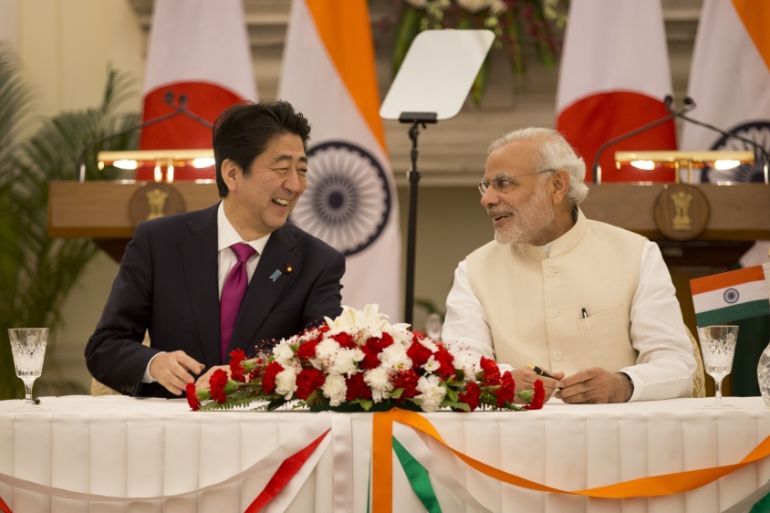India and Japan get closer as China flexes its muscles
Beijing’s cloak-and-dagger moves in the South China Sea and beyond has led to Tokyo and New Delhi become more amicable.

Beijing’s assertive moves in the South China Sea and beyond have definitely set the cat among the pigeons and led to many nations in the region scurrying for options on how to respond.
This recalibration of their national interests has brought countries such as Japan and India closer in ways like never before. Recently, in a move that is bound to raise quite a few eyebrows in Beijing, Japan and India began discussing the modalities for cooperation to set up a 15MW diesel power plant in India’s Andaman and Nicobar islands in the Bay of Bengal.
Keep reading
list of 4 itemsWhen will EVs become mainstream in the US?
Key takeaways from Xi Jinping’s European tour to France, Serbia and Hungary
Air Vanuatu goes into liquidation, thousands of passengers stranded
The Andaman and Nicobar chain of islands lie astride some of the most critical sea lanes of communication in the Indian Ocean region, which are the economic lifelines of many countries in East and Southeast Asia, including China. These islands lie close to the Strait of Malacca, which is a choke point and has been touted by some as “China’s Achilles’ heel”.
In recent times, Japan has seen its relations improve with countries such as India, the Philippines and Vietnam, while China has reached out to countries such as Cambodia and Thailand, among others.
Under President Xi Jinping, Beijing has adopted an increasingly assertive foreign policy. One reason for this could be China’s fractious internal politics as Xi tries to assert his authority domestically.
China has recently reportedly deployed missile launchers in the Woody Island in the Paracel archipelago in the South China Sea. China calls these islands Yongxing Dao.
It is worth noting that the Philippines has taken China to an international tribunal under the United Nations Convention on the Law of the Sea (UNCLOS).
‘Japan is back’
Meanwhile, in Japan, Shinzo Abe, since taking over as prime minister for the second time in December 2012, has made his intentions pretty clear. At a speech in early 2013, he declared that “Japan is not, and will never be, a tier-two country.”
Japan’s relations with China have been fraught for a couple of years, especially after the nationalisation of the Japanese-held Senkaku islands in the East China Sea.
Beijing has laid claim to these islands as the Diaoyu islands and had declared a new air defence identification zone in the region back in 2013.
In response to Beijing’s moves, the United States flew two B-52 bombers over the area while Tokyo also refused to comply with the same.
New Delhi and Beijing share a long border and a history of tensions over the same. In recent times, China's so-called 'string of pearls' strategy was raising concerns among many in New Delhi.
Japan also amended its constitution last year to allow Japanese troops to fight abroad even when Japan or Japanese interests are not directly attacked.
Additionally, The Japanese Emperor and Empress had visited the Philippines earlier this year. This is very significant as it signals the growing importance Tokyo attaches to its ties to Manila.
Washington digs in
Meanwhile, the US has also signalled its resolve to continue with its presence in the Asia-Pacific with the so-called “rebalance” to the region. Although tied up in other parts of the world such as Syria, the US still packs a punch in the Asia-Pacific region, and has unmatched force projection capabilities.
Washington has been conducting freedom of navigation operations within 12 nautical miles of Beijing’s artificial features in the South China Sea with increasing regularity.
Moreover, India, Japan, the US and Australia had earlier been part of a so-called “Quadrilateral Initiative“, back in May 2007, which had to be aborted in the light of protestations from Beijing.
OPINION: China’s aggressive posture in South China Sea
So, when the Commander of the US Pacific Command, Admiral Harry B Harris, recently remarked in New Delhi that “last year, India hosted Japan and Australia for its first ever high-level trilateral dialogue in New Delhi … an idea to consider is perhaps expanding this trilateral to a quadrilateral venue between India-Japan-Australia and the United States”, many tongues surely would have been set wagging in Beijing.
An inch closer
New Delhi and Beijing share a long border and a history of tensions over the same issue. In recent times, China’s so-called “string of pearls” strategy has seen it help to develop ports in Pakistan’s Gwadar, Sri Lanka’s Hambantota, Myanmar’s Kyaukpyu and Bangladesh’s Chittagong, raising concerns among many in New Delhi.
Beijing has also been trying to increase its presence in the Indian Ocean region, which New Delhi has traditionally seen as its own “backyard”, and has been wooing island nations such as Sri Lanka, the Maldives and the Seychelles through the “Maritime Silk Road” initiative.

This secrecy surrounding Beijing’s cloak-and-dagger moves in the South China Sea and beyond has – among other factors – led to Japan and India getting closer in the past few years.
The Indian Prime Minister Narendra Modi’s first foreign visit – beyond the Indian subcontinent – was to Japan. India’s improving ties with the US have also helped to pull Japan and India closer, as Japan is a close US ally.
The Japanese Prime Minister Shinzo Abe had remarked that “the India-Japan relationship has the greatest potential of any bilateral relationship in the world.”
In a twist of irony, it is Chinese President Xi Jinping’s oft-touted “Chinese Dream” – and consequent actions to realise this “dream” in the foreign policy arena – that now seem to have awakened other countries in the region from their stupor.
Rupakjyoti Borah is currently a research fellow with the Tokyo-based Japan Forum for Strategic Studies.
The views expressed in this article are the author’s own and do not necessarily reflect Al Jazeera’s editorial policy.
